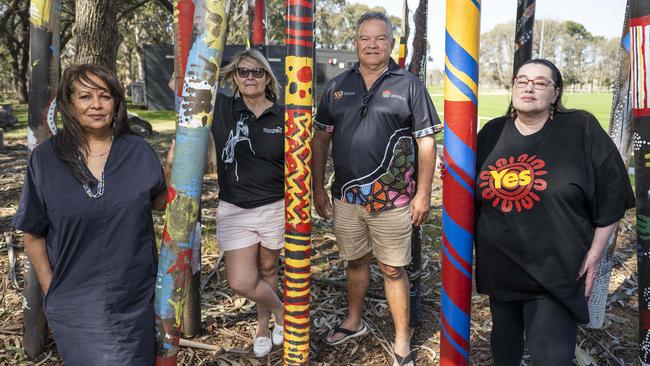ACT Indigenous body is proof voice can work, members say
The members of the nation’s first Indigenous ‘voice’ say the national voice will work, calling on Australians to back the initiative and cast their vote for Yes in this week’s referendum.

The ACT’s Indigenous voice has been running for 15 years and has had mixed outcomes, with the body helping drive infrastructure projects for Aboriginal people but also beset with infighting stemming from tribal tensions.
The ACT Aboriginal and Torres Strait Islander Elected Body has been undermined by low voter turnout, with just 2.8 per cent of Canberra’s 9500 Indigenous population casting a vote in the last election for members of the directly elected advisory group.
Elections for the seven-member body occur every three years at polling stations set up for NAIDOC Week, with representatives each taking responsibility for a portfolio to advocate for change.
An ACT Audit Office report, released this year, found a “key risk” to the body’s effectiveness included low voter turnout, the high proportion of current and former public servants and the part-time nature of the membership.
But ATSIEB chair Tanya Keed, deputy chair Paula McGrady and members Jo Chivers and Maurice Walker say it was successful and showed why a national voice should be backed by Australians on Saturday.
The members are paid about $15,000 a year for their work in the part-time position for which just seven hours a week is allocated, but they all agree it’s nowhere near enough.
Ms Chivers said the members routinely met with department heads to discuss progress and give advice on how to improve outcomes for Indigenous people, adding that she was not afraid to tell them “that’s not good enough”.
They also hold Senate estimates-style hearings where they probe the heads of government departments. “We do provide a lot of guidance to the ACT government, but in relation to how the federal voice would work, it’s the same here in the ACT; they listen to us, but then it’s up to them to decide whether they take on board our advice,” Ms Chivers said.
The members agree ATSIEB’s greatest achievements include advocating for three public housing developments to house 15 older Indigenous people, pushing for bus routes to Indigenous health clinic Winnunga Nimmitiyah and restoration of Boomanulla Oval as a community hub. It also represents the ACT at the Council of Peaks advising the government on Closing the Gap targets.
The body also struck a 10-year agreement with the ACT government in 2019 outlining goals on economic participation, health, justice and housing, among other areas, for the next decade.
The Audit Office report found the ACT government had not addressed 24 of 99 priority actions in the plan and 11 not addressed by any directorates, including celebrating the international year of Indigenous languages throughout the ACT in 2019, embedding Indigenous culture and language into government policy, and using cultural protocols and cultural proficiency measures in ACT government reporting.
Mr Walker said the report’s findings reflected the government’s unwillingness to empower ATSIEB, declaring the national body needed more power than the ACT model. “The ACT government is too scared to give autonomy to Aboriginal people.”
Despite the body being in place since 2008, the ACT lags on Closing the Gap targets including Indigenous incarceration. Twenty-six per cent of the prison population are First Nations people, despite being only 1.6 per cent of the population.
ATSIEB has suffered from a high attrition rate, with three members resigning this year, while former chair Lynnice Church was this year forced out by a vote of no confidence from other members.
Ms Church denied tribal tensions were the reason she was ousted, but The Australian understands there were concerns in the Aboriginal community that she was favouring the interests of the Ngunnawal people over other Indigenous groups.
Competing claims to traditional ownership have been a source of tension in the ACT for decades, with the Ngambri (Kamberri) people also pushing for recognition in addition to the Ngunnawal people.
The Barr government apologised to the Ngambri people after activists Paul and Leah House took their quest for recognition to the ACT Supreme Court, overturning 20 years of policy stating the Ngunnawal people were the sole traditional custodians.
Criticising the body she once led, Ms Church, a Ngunnawal woman, told The Australian its administrative practices and legislation lacked “vital elements”.
“This deficiency not only hinders the ability of the body to exercise its functions effectively but also fosters an environment conducive to lateral violence,” she said. “It’s imperative that the ACT government address these shortcomings urgently to promote cultural safety, accountability, fairness, trust and unity, which will allow ATSIEB to achieve positive outcomes for our community.”
Prominent Ngambri woman Matilda House, the 2006 Canberra Citizen of the year, is among the members of the Indigenous community who have criticised the elected body for “not dialoguing with the community at all”.
An ACT government spokeswoman said ATSIEB had been “instrumental in supporting and implementing programs and initiatives through its advocacy and active partnership”.








To join the conversation, please log in. Don't have an account? Register
Join the conversation, you are commenting as Logout